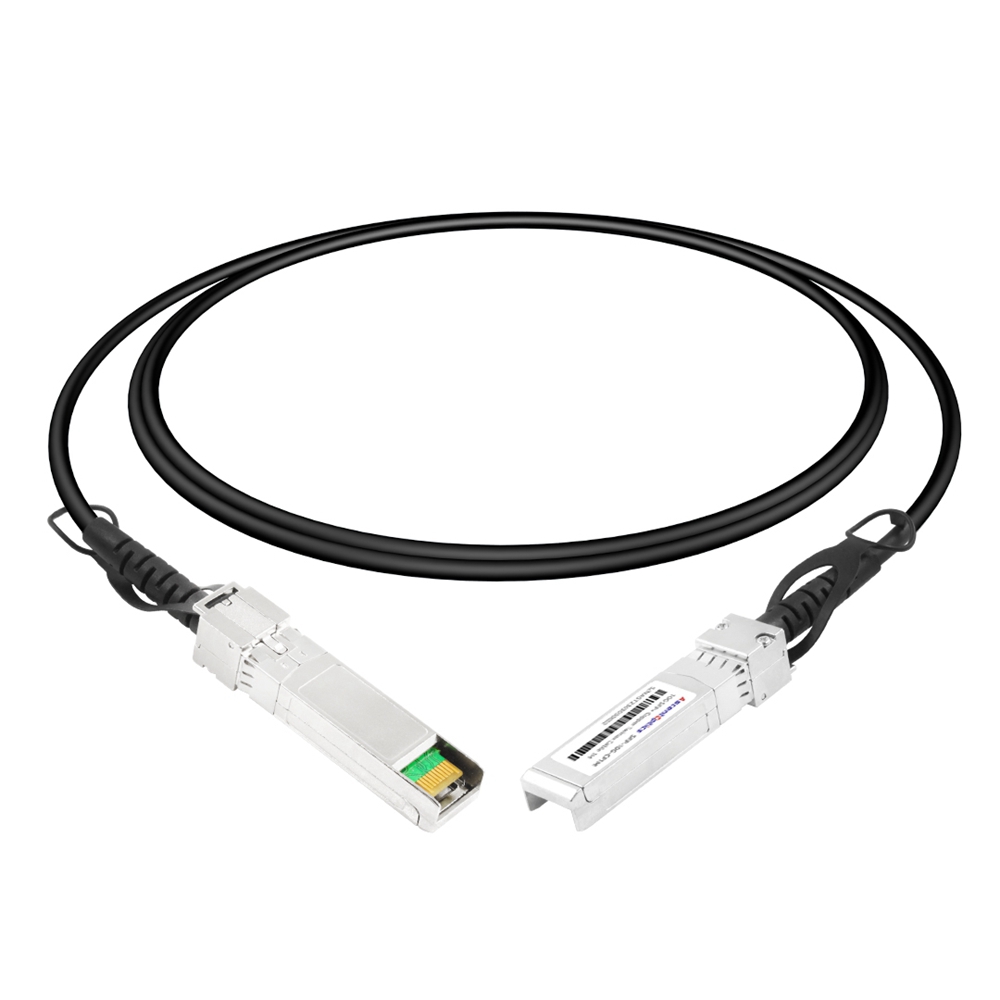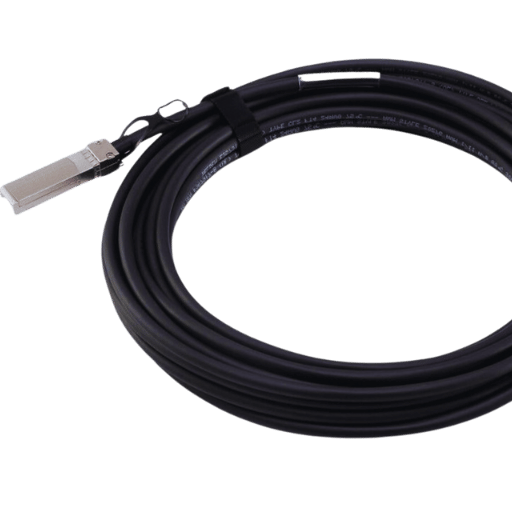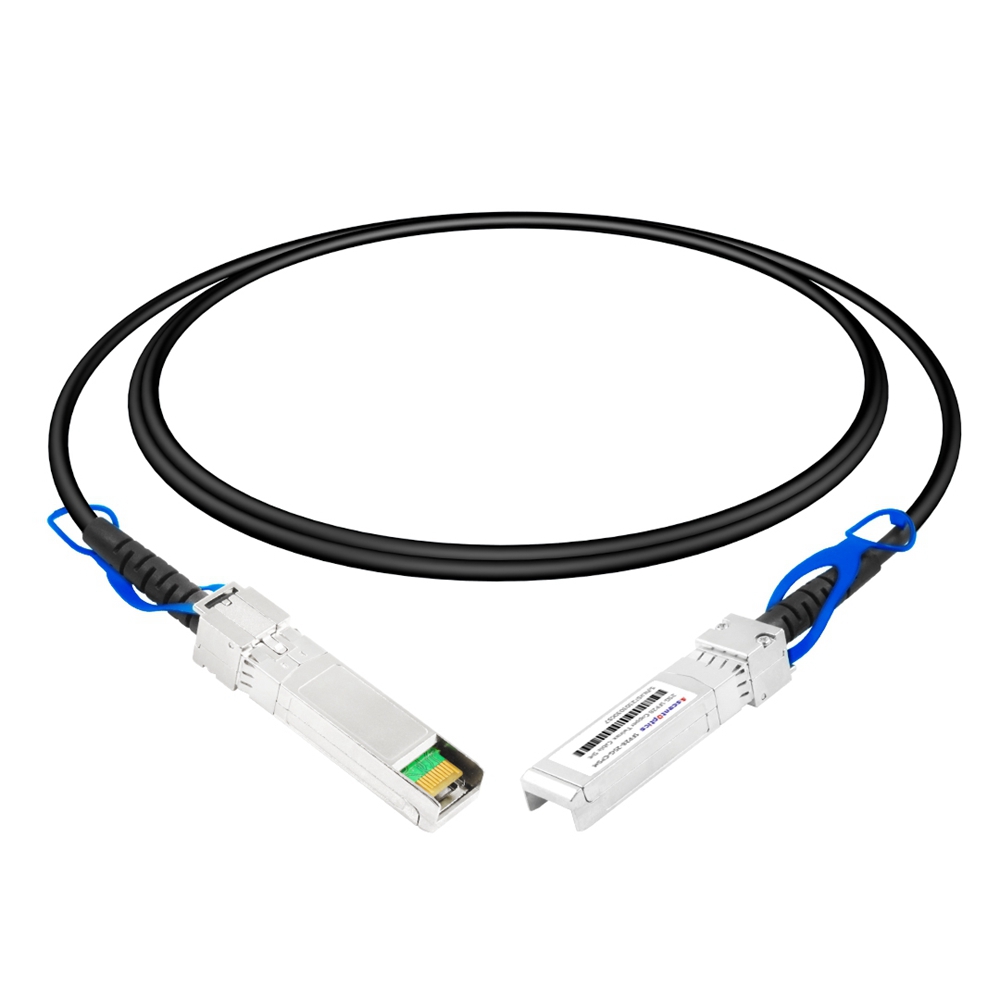SFP+ cables are essential for fast and efficient data transfer across networks in high-speed networking. Direct Attach Copper (DAC) Twinax is cost-effective and connects short distances among these types of cables. This article provides a complete guide to SFP+ Direct Attach Copper Twinax cables by discussing their design, features, advantages, and areas where they can be applied. After reading through this manual, one should be able to understand how these wires work, appreciate their relevance in different network settings, and know what needs to be done for best results during setup.

SFP+ cables, or Direct Attach Copper (DAC) Twinax cables, are a type of high-speed cable that is used for networking. Typically short-range connections within data centers, these cables are made up of twinaxial copper and have SFP+ connectors on each end, which allows them to connect directly to switches and other network devices without the need for more transceivers, thus creating less latency and using fewer power than optic fiber cables. Because they are inexpensive yet durable and easy to install, many people use SFP+ DAC Twinax Cables when needing quick data transmission over small distances.
Certain features of the Direct Attach Copper (DAC) Twinax cables can be enumerated to explain their suitability in some networking applications:
Active Twinax cables, or Active Direct Attach Cables (A-DACs) as they are commonly known, improve signal conditioning and boost transmission performance by using active electronic components. Unlike passive Twinax cables that only rely on the built-in electrical properties of the cable itself, active Twinax cables make use of integrated circuits to handle the signal; hence, this gives better results over longer distances and with more network equipment types. The advantages offered by active twinax technology are:
In summary, Active Twinax cable technology ensures strong connections as well as high performance especially where wide coverage and strong signals need to be achieved at once.

Direct attach cables (DACs) are copper cables with transceivers permanently attached at both ends, enabling network devices to be connected directly. They are inexpensive and best for short-range connections in data centers. Optical connections, however, utilize fiber optic cables and separate, swappable transceivers, which are more appropriate for longer distances and higher data rates, thus offering more flexibility and scalability in the network infrastructure.
In network connectivity, transceivers are very important because they change networking equipment’s electrical signals into optical signals and vice versa. This is what makes them able to send data over fiber optic cables, which is necessary for high-speed and long-distance data transfer. Hot-swappable SFP+ (Small Form-factor Pluggable Plus) modules are an example of such a device; they can be replaced without shutting down the whole system, hence providing flexibility in network infrastructure maintenance. These components support different data rates and distances, thus becoming key elements in achieving scalable network performance efficiency.
To incorporate SFP+ cables with Cisco and Ubiquiti products, it is necessary to know the compatibility and setup requirements of each company. When it comes to their switch and router lines, Cisco provides broad support for SFP+ modules, which guarantees easy integration using their standardized interfaces and quality assurance measures. Similarly, Ubiquiti supports SFP+ modules in devices like the UniFi Switch series, known for its cheap yet high-performance networking solutions. It is mandatory to use modules either branded by the manufacturer or confirmed compatible so as not to create any conflicts. In order to achieve the best performance and scalability, network administrators should follow the manufacturer’s configuration guidelines while leveraging firmware updates and networking protocols they recommend.

Direct Attach Copper (DAC) Twinax cables come with a number of considerable benefits for data centers. These gains are mainly associated with their being cost-effective, low latency and easy to install.
Cost-Effectiveness:
DAC Twinax cables present a cheaper option than conventional fiber optic cables especially for short-range links. This can save a lot of money which makes them perfect for budget–conscious data center operations. Recent industry reports indicate that DAC cables can be up to 70% less costly than equivalent fiber optic solutions over distances of up to 10 meters.
Low Latency:
Due to having innate characteristics of being low in latency, DAC Twinax cables suit high-frequency trading platforms as well as data-intensive applications that require speed in millisecond range. There is no much delay during transmission since they have direct electrical connections between devices which improves overall network performance.
Power Efficiency:
In terms of power consumption, DAC Twinax cables are more energy efficient compared to active optical cables (AOCs) and traditional fiber optic cables. This means lower operational costs in addition to greener data center practices.
Ease of Installation and Maintenance:
The installation process becomes easier when dealing with plug-and-play-based systems like those supported by DAC twinaxial assemblies, hence reducing configuration needs that may prolong downtimes caused by errors or omissions during setup. Moreover, due to their robustness against dust, these types hardly get damaged physically, leading them to have longer lifespans, thus requiring less maintenance effort.
Compatibility and Flexibility:
A variety of networking equipment, such as switches, routers among others from different manufacturers, supports the use of DAC twin axial line cords without any issues arising out of compatibility problems, thereby giving enterprises the freedom to mix and match various hardware components while still achieving the desired levels performance at all times within the system Performance Boundaries.
Performance:
The most common application rates for SFP + can reach up to 10Gbps, while those using QSFP+ can reach a maximum of 40Gbps. Such higher bandwidth allows faster transfer of large volumes of information over short operational distances, hence facilitating efficient workflows within limited areas where these cables are used.
In conclusion, the adoption of DAC Twinax cable in a data center brings about both financial and technical benefits, which promote effective network operation with minimal delay and reduced cost.
Several important issues make Passive Direct Attach Copper (DAC) Twinax cables the most cost-effective. They save a lot of money at the beginning because they are not as expensive as active optical cables (AOCs) or old fiber optics. Also, DAC Twinax cables use less power, which means that they cut down on electricity costs for running them. Another point is that they can be installed and maintained easily, thus reducing labor hours and downtime spent fixing them. At the same time, these cables are compatible with many devices, so different hardware can be chosen without having to be replaced often. To sum up, this type of data center cabling offers significant economic benefits in terms of both capital expenditure and operational cost reduction.
DAC Twinax cables are renowned for being easy to install, especially when they come in standardized sizes: one meter long, two meters long, and three meters long. The way that these plug-and-play devices have been designed means there’s no need for extra transceivers or media converters, which simplifies setup. With different lengths available, it becomes possible to use them in any part of a data center regardless of how much space is around – so there will never be too many wires where they’re not needed, and everything stays neat. And because DAC Twinax cables are built tough enough that you can’t damage them just by installing them (which also makes things easier), this reduces the chances even further for something going wrong with your network while setting it up.

When selecting the right DAC Twinax cable for your needs, it is important to take into account port compatibility as well as DAC type. Making sure that the DAC cables are compatible with ports on network devices can help avoid problems with connectivity and enhance performance. Here are some of the main technical considerations along with relevant information to support decision-making.
Compatibility of Ports
Type of DAC
By ensuring port compatibility and choosing the right type of DAC Twinax cable, you can seamlessly integrate it into your existing infrastructure – thus maximizing performance while keeping costs down.
In evaluating whether to use active or passive DACs, there are several technical considerations. These include distance capabilities, performance, power requirements and cost.
Capabilities based on distance:
Performance:
Power Requirements:
Cost:
In order to ascertain the quality of Direct Attach Cables (DACs), it is necessary to test them according to strict standards of evaluation, which vouch for their performance and dependability. The following are some of the major standards followed by most top-tier producers:
By following these commonly accepted criteria when producing DACs, manufacturers will be able to deliver safe-to-use, high-quality DACSs that meet global regulatory demands.

Distance of Transmission:
Data Transfer Rate:
Interference:
Installation and Maintenance:
Cost:
Latency:
Power Consumption:
Cable Length:
Application Suitability:
Deployment Cost:
Data centers: Given the fact that data processing and transmission need to be faster by the day, it is no surprise to find 10G cables used in most data centers. The reason behind this is to establish high-speed connectivity between servers, storage systems as well as network switches. To put it differently; distance between racks needs a short connection which supports low latency and wide bandwidth like 10GBase-CU.
Enterprise networks: In corporate settings, people tend to choose 10GBase-T because it can work with longer cables of up to 100 meters. Therefore, this makes such an option best when connecting various parts within a building or office thus enabling fast access towards centralized resources while at the same time allowing for easy integration of data intensive applications.
Telecommunications: Nowadays, telecommunication companies require higher throughputs due to modern infrastructures; hence, these firms need to invest in 10GBase-T technology. This kind supports large amounts of cabling along with fast transfer rates, which will ensure that many people are served with reliable connections both now and in the future while taking care of current needs.
High-Performance Computing (HPC): Clusters that engage themselves in sophisticated calculations contain many computers that work together. However, achieving optimal computational performance becomes possible only if minimal latency is guaranteed, among other things. Intra-rack connections using 10G cables, particularly those of type 10Gbase-CU, should be considered since they offer the highest throughput coupled with the lowest delays needed for high-performance computing (HPC).
A: An SFP+ cable, also called 10g SFP, is a network cable used to transfer data at high speeds, most commonly within data centers. Unlike regular Ethernet cables, these are designed for short-range communication with low latency, such as 10gbase-cu passive direct-attach copper.
A: Passive copper direct-attach cables have less delay, lower power consumption, and are cost-effective, among other advantages. They are best suited for transmitting data over short distances and are widely employed in high-speed networks.
A: Passive sfp-10g-01c has no signal amplification hence can only function within a maximum distance of 7 meters while active ones contain electronics that boost the signal enabling them work over longer distances too. Both types are used in areas demanding fast data transfer rates.
A: Some SFPs may not work universally on every device, which is why compatibility checks are important. For instance, ubiquiti unifi uc-dac-sfp or 10gtek 10gbase-t sfp are compatible 10g sfp cables explicitly meant for use with certain equipment; thus, always refer to device documentation ensuring compatibility.
A: These are commonly found in data centers and enterprise environments, connecting switches, routers, and servers. They support fast 10GbE (Gigabit Ethernet) connections that require large amounts of bandwidth and reliable performance, making them ideal for such setups.
A: Installation times may differ, but generally, the installation of passive sfp 10gbase-cu sfp, for instance, is fast and simple. Most users expect to complete this task within a month after delivery if they have the necessary tools and skills.
A: It depends on what you need. Compared to fiber patch cables, which are less affected by electromagnetic interference at longer distances, data centers that require short connections may find an SFP+ cable like Twinx Copper more cost-effective and manageable.
A: While purchasing, pay attention to length, whether active or passive copper ethernet or compatibility with devices like compatible 10g sfp for your specific network equipment; do you need copper or fiber solution? Also, look for the right connectors in cables and ensure they meet required performance standards.
A: Yes, there are. For example, it is easier and cheaper to install 10gbase-cu passive direct-attach copper than any other type of wire over short distances. On the other hand, fibers are better suited for long-range connections where high levels of EMI could be present in the environment surrounding them. Thus, choice should depend upon particular network needs and prevailing environmental conditions.